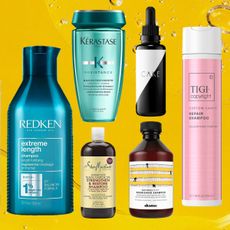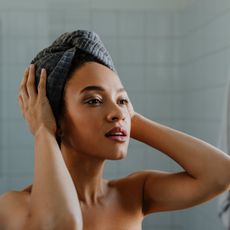
While rock stars (both ladies and gents), off-duty models, and Kristen Stewart will always make a convincing case for sleeping in our eye makeup for that smoky, lived-in look, it's still no excuse for hitting the pillow winged liner intact, lashes coated and curled.
The harm? Well, for one, it will make your eyes puffy, which is hardly a sought-after look. Plus, over time, said puffiness can cause pre-mature aging as it lends itself to wrinkling and sagging. Not too mention, your product will become flaky and melty as you wear it for more than 12 hours.(Sorry, pillows.)
But on the other hand, removing your makeup can be a catch 22. If you're not gentle or using the right formula, it can put a similar strain on the delicate, wrinkle-prone skin around your eyes. Don't freak out just yet—to ensure that you're getting every last lick of makeup off in non-abrasive fashion, we've got some easy to remember tips.
Remove your eye makeup before you wash your face
It's a two-step process. "Many cleansers can't take off concealer or foundation completely, especially around the eyes and nose," explains dermatologist Jeanine Downie. Which brings us to our next pearl of wisdom...
Don't use your face wash to remove makeup
Again, when it comes to getting rid of more potent formulas like waterproof mascara, it won't get the job done and will leave a damaging residue or, if you're really not careful, raccoon eyes.
Use a gentle, yet effective eye makeup remover
It doesn't necessarily need to be store bought, but if it is, look for an oil-based formula, but make sure it's not so oily that it leaves a residue. How do you know it's working? It breaks down pigment and rinses off easily, without intense scrubbing. We loveMAC Cleanse Off Oil ($31) for all skin types. (Pro tip: If you're in a bind or just want to go a more economical route, you can also use your moisturizer or household items such as avocados, petroleum jelly, or grape seed oil. But be mindful, they might not be as effective.)
Use natural cotton pads and Q-tips
We can't stress it enough: Don't take the delicate skin around your eyes for granted. While using your fingers or a tissue might get the job done, natural cotton pads will be far less abrasive on the skin. Plus, you can pre-moisten them for the most effective, pigment-pulverizing impact upon contact. For the hard-to-reach areas around the eye, like the creases or between lashes, Q-tips might be essential.
Stay In The Know
Marie Claire email subscribers get intel on fashion and beauty trends, hot-off-the-press celebrity news, and more. Sign up here.
Press product in, then wipe downward
After you've saturated a pad with product, press it down around your eye and allow it to dissolve so that less rubbing will be necessary. When massaging the product around your eyes, do so in a circular motion and *always* be sure to wipe downward.
Don't use cleansing cloths daily
They'll best serve you as a last resort. For one, they're designed more so so for the face then the sensitive eye area. Plus, if they contain alcohol, they can be irritating and dry out the skin. "They contain preservatives to make them safe from a 'freshness' standpoint, but these same preservatives are not necessarily safe to leave on your skin," explains Rachel Nazarian, M.D. at Schweiger Dermatology Group.
Keep waterproof mascara use to a minimum
It may hold gloriously through the day (and an onslaught of tears) but waterproof mascara will always make the eye makeup removal process more challenging, time-consuming, and worst of all, stressful on the eyes.

Lauren is the former beauty editor at Marie Claire. She love to while away the hours at coffee shops, hunt for vintage clothes, and bask in the rough-and-tumble beauty of NYC. She firmly believes that solitude can be a luxury if you’ve got the right soundtrack—that being the Rolling Stones, of course.
-
 Princess Eugenie Posts Sweet Birthday Message to Husband Jack Brooksbank
Princess Eugenie Posts Sweet Birthday Message to Husband Jack Brooksbank"Always making joy wherever you are."
By Danielle Campoamor Published
-
 Bindi Irwin Opens Up About Her Decision to Go Public With Endometriosis Diagnosis
Bindi Irwin Opens Up About Her Decision to Go Public With Endometriosis Diagnosis"My fear was not knowing what would happen when I stepped off into that world of sharing my journey."
By Danielle Campoamor Published
-
 Kate Middleton is Expected to Stay Away From "Public Duties for Some Time"
Kate Middleton is Expected to Stay Away From "Public Duties for Some Time"The Princess of Wales will be able to attend events "when she feels able to," reports say.
By Danielle Campoamor Published
-
 Why Beauty Experts Are Calling Out Youthforia's New Foundation
Why Beauty Experts Are Calling Out Youthforia's New FoundationThis isn't the way to do inclusive shades.
By Halie LeSavage Published
-
 The 32 Best Hair Growth Shampoos of 2024, According to Experts
The 32 Best Hair Growth Shampoos of 2024, According to ExpertsRapunzel hair, coming right up.
By Gabrielle Ulubay Published
-
 The 20 Best Hair Masks for Damaged Hair, According to Experts and Editors
The 20 Best Hair Masks for Damaged Hair, According to Experts and EditorsHealthy strands, here we come!
By Gabrielle Ulubay Last updated
-
 How Often You Should Wash Your Hair, According To Experts
How Often You Should Wash Your Hair, According To ExpertsKeep it fresh, my friends.
By Gabrielle Ulubay Published
-
 The 11 Best Magnetic Lashes of 2023
The 11 Best Magnetic Lashes of 2023Go ahead and kiss your messy lash glue goodbye.
By Hana Hong Published
-
 Beauty Advent Calendars Make the Perfect Holiday Gift
Beauty Advent Calendars Make the Perfect Holiday GiftThe gift that keeps on giving.
By Julia Marzovilla Last updated
-
 The 18 Best Natural Hair Products in 2023
The 18 Best Natural Hair Products in 2023Remember: Your curls are your crown.
By Gabrielle Ulubay Published
-
 The 9 Best Hot Rollers for the Curls of Your Dreams
The 9 Best Hot Rollers for the Curls of Your DreamsThis is how we roll.
By Samantha Holender Published